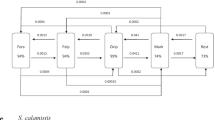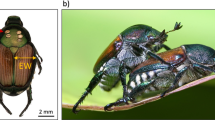Abstract
Searching behavior ofAmitus hesperidum Silvestri andEncarsia opulenta (Silvestri) for immatureAleurocanthus woglumi Ashby was similar. Both parasitoids moved unidirectionally until they encountered a host aggregation at which time they changed to a pattern of short walks with numerous turns. Parasitoid ovipositor insertion was generally at midbody between the host sternites and tergites.Amitus hesperidum females showed a significant preference for 1st instar hosts, have an ovipositional marker, do not feed on exudates from ovipositional wounds (host feed), and have significantly shorter ovipositional times and adult life spans thanE. opulenta which showed a significant preference for 2nd instar hosts, lack an ovipositional marker, and host feed.Encarsia opulenta females showed a significant preference for hosts previously parasitized byA. hesperidum but the reverse was not true. The average number of hosts parasitized by females of both parasitoid species was uninfluenced by the previous presence of the other parasitoid species on the same leaf.
Résumé
Le comportement de recherche des stades immatures deAleurocanthus woglumi Ashby est semblable chezAmitus hesperidum Silvestri et chezEncarsia opulenta (Silvestri). Les 2 parasitoides se déplacent directement jusqu'à la rencontre d'un amas d'hôtes; ils exécutent alors de courtes marches en se retournant fréquemment. L'insertion de l'ovipositeur du parasitoide a lieu généralement à mi-corps entre les tergites et les sternites de l'hôte. Les femelles deAmitus hesperidum montrent une préférence significative pour le 1er stade de l'aleurode, ont un marqueur de dépôt de l'œuf, ne s'alimentent pas sur les blessures créées par leur ponte (alimentation aux dépens de l'hôte) et présentent, des délais de ponte et une longévité imaginale significativement plus courts que chezE. opulenta, qui fait preuve d'une préférence pour des hôtes au 2e stade, n'a pas de marqueur de ponte et se nourrit aux dépens de l'aleurode. Les femelles deE. opulenta montrent une préférence nette pour des hôtes déjà parasités parA. hesperidum alors que la réciproque n'existe pas. Le nombre moyen d'hôtes parasités par les femelles des 2 espèces n'est pas modifié par la présence antérieure d'autres espèces de parasitoides sur la même feuille.
Similar content being viewed by others
References
Cherry, R. &Pastor, S. — 1980. Variations in population levels of citrus balckfly,Aleurocanthus woglumi [Hom.: Aleyrodidae] and parasites during an eradication program in Florida. —Entomophaga, 25, 367–370.
Dowell, R. V. — 1978. Ovary structure and reproductive biologies of larval parasitoids of the alfalfa weevil [Coleoptera: Curculionidae]. —Can. Entomol., 110, 507–512.
— — 1979. Synchrony and impact ofAmitus hesperidum [Hym.: Platygasteridae] on its host,Aleurocanthus woglumi [Hom.: Aleyrodidae] in southern Florida. —Entomophaga, 24, 221–227.
Dowell, R. V., Fitzpatrick, G. E. &Reinert, J. A. — 1979. Biological control of citrus blackfly in southern Florida. —Environ. Entomol., 8, 595–597.
Flanders, S. E. — 1935. An apparent correlation between the feeding habits of certain pteromalids and the condition of their ovarian follicles. —Ann. Entomol. Soc. Am., 28, 428–444.
— — 1969.Herbert D. Smith's observation on citrus blackfly parasites in India and the correlated circumstances. —Can. Entomol., 101, 467–480.
Hart, W. G., Selhime, A. G., Harlan, D. P., Ingle, S. J., Sanches-R., M., Rhode, R. H., Garcia, C. A., Caballero, J. &Garcia, R. L. — 1978. The introduction and establishment of parasites of citrus blackfly,Aleurocanthus woglumi Ashby, in Florida. —Entomophaga, 23, 361–366.
Ketner, C. F. &Rosier, J. G. — 1978. Citrus blackfly controlled biologically. —Tex. Agric. Prog., 21, 19–20.
Quesada, J. R. — 1974. Biological control ofAleurocanthus woglumi [Hom.: Aleyrodidae] in El Salvador. —Entomophaga, 19, 243–254.
Richardson, H. H. — 1949. Present status of the citrus blackfly and its parasiteEretmocerus serius at Nassau, Bahamas. —J. Econ. Entomol., 41, 980.
Selhime, A. G. — 1980. Biological control of citrus blackfly in south Florida. —Proc. Fla. State Hortic. Soc., 92, 32–33.
Smith, H. D., Maltby, L. & Jimenez, E. J. — 1964. Biological control of the citrus blackfly in Mexico. —U.S.D.A. Bull., 1311, 29 pp.
Van Lenteren, J. C., Nell, H. W. &Sevenster-van der Lelie, L. A. — 1980. The parasite-host relationship betweenEncarsia formosa [Hymenoptera: Aphelinidae] andTrialeurodes vaporariorum [Homoptera: Aleyrodidae]. —Z. Angew. Entomol., 89, 442–454.
Viggiani, G. &Mazzone, P. — 1979. Contributi alla conoscenza morfobiologica delle specie del complessoEncarsia Foester-Prospaltella Ashmead [Hym.: Aphelinidae] 1. Un commento sull' attuale stato con proposte sinonimiche e descrizione deEncarsia silvestrii n. sp., parassita deBemesia citricola Gom. Men. [Hom.: Aleyrodidae]. —Boll. Lab. Entomol. Agrar. Silvestri, 36, 42–50.
Author information
Authors and Affiliations
Additional information
Partially supported by Cooperative Agreement =12-14-7001-1148 between University of Florida and USDA-SEA. Florida Agricultural Experiment Station Journal Series No. 2771.
Rights and permissions
About this article
Cite this article
Dowell, R.V., Puckett, D. & Johnson, M. Searching and ovipositional behavior ofAmitus hesperidum [Hym.: Platygasteridae] andEncarsia opulenta [Hym.: Aphelinidae] parasitoids of the citrus blackfly [Hom.: Aleyrodidae]. Entomophaga 26, 233–239 (1981). https://doi.org/10.1007/BF02371873
Issue Date:
DOI: https://doi.org/10.1007/BF02371873




